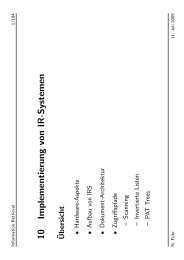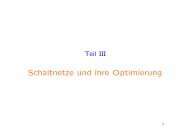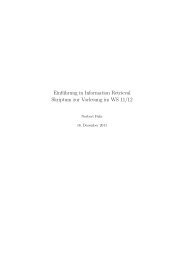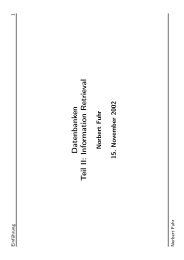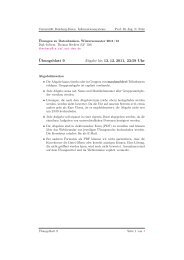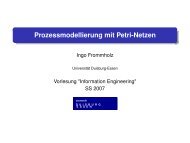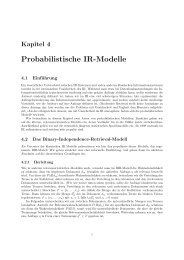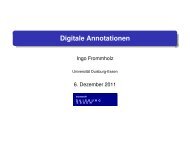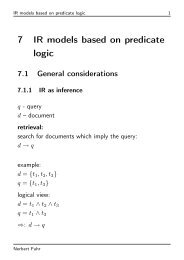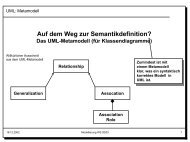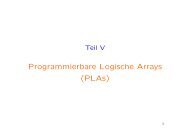pDAML+OIL: A probabilistic extension to DAML+OIL based on ...
pDAML+OIL: A probabilistic extension to DAML+OIL based on ...
pDAML+OIL: A probabilistic extension to DAML+OIL based on ...
Create successful ePaper yourself
Turn your PDF publications into a flip-book with our unique Google optimized e-Paper software.
<str<strong>on</strong>g>p<str<strong>on</strong>g>DAML+OIL</str<strong>on</strong>g></str<strong>on</strong>g>: A <str<strong>on</strong>g>probabilistic</str<strong>on</strong>g> <str<strong>on</strong>g>extensi<strong>on</strong></str<strong>on</strong>g> <str<strong>on</strong>g>to</str<strong>on</strong>g> <str<strong>on</strong>g>DAML+OIL</str<strong>on</strong>g><br />
<str<strong>on</strong>g>based</str<strong>on</strong>g> <strong>on</strong> <str<strong>on</strong>g>probabilistic</str<strong>on</strong>g> Datalog<br />
Henrik Nottelmann<br />
University of Duisburg-Essen<br />
47048 Duisburg, Germany<br />
nottelmann@uni-duisburg.de<br />
Norbert Fuhr<br />
University of Duisburg-Essen<br />
47048 Duisburg, Germany<br />
fuhr@uni-duisburg.de<br />
Abstract<br />
As a representative of <strong>on</strong><str<strong>on</strong>g>to</str<strong>on</strong>g>logy languages,<br />
<str<strong>on</strong>g>DAML+OIL</str<strong>on</strong>g> is well-suited for<br />
describing objects and their properties.<br />
We show that real-life problems<br />
require uncertain facts and general<br />
rules, which are not supported by<br />
<str<strong>on</strong>g>DAML+OIL</str<strong>on</strong>g>. We extend <str<strong>on</strong>g>DAML+OIL</str<strong>on</strong>g><br />
accordingly while preserving as much<br />
of the original semantics as possible,<br />
by mapping <str<strong>on</strong>g>DAML+OIL</str<strong>on</strong>g> models <strong>on</strong><str<strong>on</strong>g>to</str<strong>on</strong>g><br />
<str<strong>on</strong>g>probabilistic</str<strong>on</strong>g> Datalog.<br />
Keywords: <str<strong>on</strong>g>DAML+OIL</str<strong>on</strong>g>, probability<br />
theory, logics<br />
1 Introducti<strong>on</strong><br />
The Semantic Web aims at transforming the currently<br />
text-<str<strong>on</strong>g>based</str<strong>on</strong>g> web in<str<strong>on</strong>g>to</str<strong>on</strong>g> a network of informati<strong>on</strong><br />
with a well-defined meaning, which allows<br />
for sharing and reusing it across applicati<strong>on</strong>s and<br />
communities. One major focus lies <strong>on</strong> defining<br />
standards for representing knowledge by means<br />
of <strong>on</strong><str<strong>on</strong>g>to</str<strong>on</strong>g>logies. Turning the visi<strong>on</strong> of a web with<br />
semantics in<str<strong>on</strong>g>to</str<strong>on</strong>g> something practical is a l<strong>on</strong>g-term<br />
goal, where a lot of problems of the current approaches<br />
have <str<strong>on</strong>g>to</str<strong>on</strong>g> be overcome.<br />
One of the Semantic Web languages <str<strong>on</strong>g>based</str<strong>on</strong>g> <strong>on</strong> descripti<strong>on</strong><br />
logics is <str<strong>on</strong>g>DAML+OIL</str<strong>on</strong>g> [11], built <strong>on</strong> <str<strong>on</strong>g>to</str<strong>on</strong>g>p<br />
of RDF and RDF Schema.<br />
RDF [10] is a specificati<strong>on</strong> language for objects<br />
and their properties via statements (also called<br />
triples): Its subject is an RDF object, the predicate<br />
is a property, and the object is another RDF<br />
object or a literal (a c<strong>on</strong>stant). The vocabulary can<br />
be defined with the schema specificati<strong>on</strong> language<br />
RDF Schema (RDFS for short) [12].<br />
<str<strong>on</strong>g>DAML+OIL</str<strong>on</strong>g> enriches RDFS with more advanced<br />
primitives: E.g. the range of a property can be<br />
specified w.r.t. the domain (in RDFS, it can <strong>on</strong>ly<br />
be specified globally).<br />
However, the <str<strong>on</strong>g>DAML+OIL</str<strong>on</strong>g> language has two significant<br />
restricti<strong>on</strong>s:<br />
1. As nearly all <strong>on</strong><str<strong>on</strong>g>to</str<strong>on</strong>g>logy languages,<br />
<str<strong>on</strong>g>DAML+OIL</str<strong>on</strong>g> is <strong>on</strong>ly able <str<strong>on</strong>g>to</str<strong>on</strong>g> specify and infer<br />
deterministic knowledge (which is either<br />
true or false). However, not all knowledge<br />
in the world is deterministic, uncertainty<br />
often plays an important role, and weights<br />
are required. They can be used <str<strong>on</strong>g>to</str<strong>on</strong>g> model<br />
assumpti<strong>on</strong>s about missing knowledge, e.g.<br />
the probability that some<strong>on</strong>e is the father<br />
of a child unless this is certified by a test.<br />
Weights can also be used for specifying<br />
vague informati<strong>on</strong> needs.<br />
2. <str<strong>on</strong>g>DAML+OIL</str<strong>on</strong>g> does not support rules (besides<br />
properties like rdfs:subClassOf which<br />
could be viewed as rules). DAML-L is intended<br />
<str<strong>on</strong>g>to</str<strong>on</strong>g> add rules <str<strong>on</strong>g>to</str<strong>on</strong>g> <str<strong>on</strong>g>DAML+OIL</str<strong>on</strong>g>, but this<br />
language is not yet completed. Rules can be<br />
used as a powerful query language, and are<br />
manda<str<strong>on</strong>g>to</str<strong>on</strong>g>ry for Semantic Web Services. E.g.,<br />
a travel planning system needs rules for deciding<br />
whether a specific flight and a specific<br />
hotel matches the user needs for a specific<br />
trip. They can also be used as a declarative<br />
way for defining schema mapping rules,<br />
when documents (or queries) have <str<strong>on</strong>g>to</str<strong>on</strong>g> be<br />
transformed from <strong>on</strong>e schema in<str<strong>on</strong>g>to</str<strong>on</strong>g> another.
Reificati<strong>on</strong> (statements about statements) is used<br />
in [6] for supporting uncertainty. Then, the property<br />
prob of a statement specifies the probability<br />
that this statement is correct. Reificati<strong>on</strong> is supported<br />
by RDFS, but <str<strong>on</strong>g>DAML+OIL</str<strong>on</strong>g> <str<strong>on</strong>g>to</str<strong>on</strong>g>ols cannot<br />
give any semantics <str<strong>on</strong>g>to</str<strong>on</strong>g> such triples.<br />
In c<strong>on</strong>trast <str<strong>on</strong>g>to</str<strong>on</strong>g> this approach, we now extend the<br />
language itself <str<strong>on</strong>g>to</str<strong>on</strong>g> solve both problems. First we<br />
map <str<strong>on</strong>g>DAML+OIL</str<strong>on</strong>g> <strong>on</strong><str<strong>on</strong>g>to</str<strong>on</strong>g> <str<strong>on</strong>g>probabilistic</str<strong>on</strong>g> Horn logics,<br />
namely Datalog, while preserving the semantics.<br />
We then employ its <str<strong>on</strong>g>probabilistic</str<strong>on</strong>g> <str<strong>on</strong>g>extensi<strong>on</strong></str<strong>on</strong>g>,<br />
<str<strong>on</strong>g>probabilistic</str<strong>on</strong>g> Datalog (pDatalog for short)<br />
[2] for defining the semantics of <str<strong>on</strong>g>probabilistic</str<strong>on</strong>g><br />
<str<strong>on</strong>g>DAML+OIL</str<strong>on</strong>g>, and for introducing rules. This approach<br />
has the advantage of using an existing<br />
framework for which <str<strong>on</strong>g>to</str<strong>on</strong>g>ols (HySpirit [3], or a<br />
mapping <strong>on</strong><str<strong>on</strong>g>to</str<strong>on</strong>g> relati<strong>on</strong>al databases) are already<br />
available. This is important because our major<br />
goal is <str<strong>on</strong>g>to</str<strong>on</strong>g> develop actual applicati<strong>on</strong>s for our approach.<br />
This paper is organised as follows. First we<br />
give a brief introducti<strong>on</strong> in <str<strong>on</strong>g>probabilistic</str<strong>on</strong>g> Datalog.<br />
Secti<strong>on</strong> 3 shows how <str<strong>on</strong>g>DAML+OIL</str<strong>on</strong>g> models<br />
can be mapped <strong>on</strong><str<strong>on</strong>g>to</str<strong>on</strong>g> pDatalog programs. Uncertainty<br />
and rules are added <str<strong>on</strong>g>to</str<strong>on</strong>g> <str<strong>on</strong>g>DAML+OIL</str<strong>on</strong>g> in<br />
Sec. 4. Then, an example (a travel planning system)<br />
shows how pDatalog and rules can be used<br />
in practice.<br />
2 Probabilistic Datalog<br />
This secti<strong>on</strong>s gives a brief overview over Datalog<br />
and its <str<strong>on</strong>g>probabilistic</str<strong>on</strong>g> <str<strong>on</strong>g>extensi<strong>on</strong></str<strong>on</strong>g>s two-valued and<br />
four-valued <str<strong>on</strong>g>probabilistic</str<strong>on</strong>g> Datalog.<br />
2.1 Datalog<br />
Datalog [8] is a variant of predicate logic <str<strong>on</strong>g>based</str<strong>on</strong>g><br />
<strong>on</strong> functi<strong>on</strong>-free Horn clauses. Negati<strong>on</strong> is allowed,<br />
but its use is limited <str<strong>on</strong>g>to</str<strong>on</strong>g> achieve a correct<br />
and complete model. Rules have the form<br />
h ← b 1 ∧···∧b n , where h (the “head”) and b i (the<br />
subgoals of the “body”) denote literals 1 with variables<br />
and c<strong>on</strong>stants as arguments. A rule can be<br />
seen as a clause {h,¬b 1 ,...,¬b n }:<br />
father(X,Y) :- parent(X,Y) & male(X).<br />
1 Literals in logics are different from literals in<br />
<str<strong>on</strong>g>DAML+OIL</str<strong>on</strong>g>!<br />
This denotes that father(x,y) is true for two<br />
c<strong>on</strong>stants x and y if both parent(x,y) and<br />
male(x) are true. This rule has the head<br />
father(X,Y) and two body literals (c<strong>on</strong>sidered<br />
as a c<strong>on</strong>juncti<strong>on</strong>) parent(X,Y) and male(X).<br />
In additi<strong>on</strong>, negated literals start with an exclamati<strong>on</strong><br />
mark. Variables start with an uppercase<br />
character, c<strong>on</strong>stants with a lowercase character.<br />
Thus the rule expresses the semantics behind the<br />
rdfs:subClassOf property.<br />
A fact is a rule with <strong>on</strong>ly c<strong>on</strong>stants in the head and<br />
an empty body:<br />
parent(jo,mary).<br />
The semantics are defined by well-founded models<br />
[9], which are <str<strong>on</strong>g>based</str<strong>on</strong>g> <strong>on</strong> the noti<strong>on</strong> of the greatest<br />
unfounded set. Informally speaking, given<br />
a partial interpretati<strong>on</strong> of a program, this is the<br />
maximum set of ground literals that can be assumed<br />
<str<strong>on</strong>g>to</str<strong>on</strong>g> be false.<br />
Only modularly stratified programs [7] are allowed.<br />
Since the definiti<strong>on</strong> of modular stratificati<strong>on</strong><br />
is rather complicated, we <strong>on</strong>ly give a simple<br />
explanati<strong>on</strong>: In c<strong>on</strong>trast <str<strong>on</strong>g>to</str<strong>on</strong>g> global stratificati<strong>on</strong>,<br />
modular stratificati<strong>on</strong> is formulated w.r.t. the instatiati<strong>on</strong><br />
of a program for its Herbrand universe.<br />
The program is modularly stratified if there is an<br />
assignment of ordinal levels <str<strong>on</strong>g>to</str<strong>on</strong>g> ground a<str<strong>on</strong>g>to</str<strong>on</strong>g>ms such<br />
that whenever a ground a<str<strong>on</strong>g>to</str<strong>on</strong>g>m appears negatively<br />
in the body of a rule, the ground a<str<strong>on</strong>g>to</str<strong>on</strong>g>m in the head<br />
of that rule is of strictly higher level, and whenever<br />
a ground a<str<strong>on</strong>g>to</str<strong>on</strong>g>m appears positively in the body<br />
of a rule, the ground a<str<strong>on</strong>g>to</str<strong>on</strong>g>m in the head has at least<br />
that level.<br />
2.2 Probabilistic Datalog<br />
In <str<strong>on</strong>g>probabilistic</str<strong>on</strong>g> Datalog (see [2]), every fact<br />
or rule has a <str<strong>on</strong>g>probabilistic</str<strong>on</strong>g> weight attached,<br />
prepended <str<strong>on</strong>g>to</str<strong>on</strong>g> the fact or rule:<br />
0.5 male(X) :- pers<strong>on</strong>(X).<br />
0.5 male(jo).<br />
Semantics of pDatalog programs are defined as<br />
follows: The pDatalog program is modelled as a<br />
probability distributi<strong>on</strong> over the set of all “possible<br />
worlds”. A possible world is the well-founded<br />
model of a possible deterministic program, which<br />
is formed by the deterministic part of the program
and a subset of the indeterministic part. As for deterministic<br />
Datalog, <strong>on</strong>ly modularly stratified programs<br />
are allowed.<br />
Computati<strong>on</strong> of the probabilities is <str<strong>on</strong>g>based</str<strong>on</strong>g> <strong>on</strong> the<br />
noti<strong>on</strong> of event keys and event expressi<strong>on</strong>s, which<br />
allow for recognising duplicate or disjoint events<br />
when computing a <str<strong>on</strong>g>probabilistic</str<strong>on</strong>g> weight.<br />
Facts and instantiated rules are basic events, each<br />
of them has assigned a unique event key. Each derived<br />
fact is associated with an event expressi<strong>on</strong><br />
that is a Boolean combinati<strong>on</strong> of the event keys<br />
of the underlying basic events. E.g., the event expressi<strong>on</strong>s<br />
of the subgoals of a rule form a c<strong>on</strong>juncti<strong>on</strong>.<br />
If there are multiple rules for the same<br />
head, the event expressi<strong>on</strong>s corresp<strong>on</strong>ding <str<strong>on</strong>g>to</str<strong>on</strong>g> the<br />
rule bodies form a disjuncti<strong>on</strong>. By default, events<br />
are assumed <str<strong>on</strong>g>to</str<strong>on</strong>g> be independent, so the probabilities<br />
can be multiplied.<br />
2.3 Four-valued Probabilistic Datalog<br />
In four-valued <str<strong>on</strong>g>probabilistic</str<strong>on</strong>g> Datalog [3], we<br />
switch from the closed-world assumpti<strong>on</strong> in Datalog<br />
<str<strong>on</strong>g>to</str<strong>on</strong>g> an open-world assumpti<strong>on</strong>: If we d<strong>on</strong>’t<br />
have any informati<strong>on</strong>, the fact has the truth value<br />
“unknown”. On the other hand, a fact has the truth<br />
value “inc<strong>on</strong>sistent” if there is evidence for both<br />
true and false.<br />
For facts, probabilities for true, false and inc<strong>on</strong>sistent<br />
have <str<strong>on</strong>g>to</str<strong>on</strong>g> be specified manually, the probability<br />
for unknown can then be derived easily.<br />
0.6/0.2/0.2 male(jo).<br />
0.9 female(maria).<br />
!male(laura).<br />
!male(X) :- female(X).<br />
Jo is a man with probability 0.6, not a man with<br />
probability 0.2, and the knowledge is inc<strong>on</strong>sistent<br />
with probability 0.2. For Maria, the “0.9” is a<br />
short form for “0.9/0.1/0”. Laura is not a man,<br />
and women are not men (here, the negated head<br />
stands for the probabilities “0/1/0”).<br />
If positive and negative rules are true for a fact in<br />
the head, then this fact is inc<strong>on</strong>sistent.<br />
A model of a deterministic Datalog program<br />
can c<strong>on</strong>tain— for a specific fact—the positive<br />
a<str<strong>on</strong>g>to</str<strong>on</strong>g>m, the negated a<str<strong>on</strong>g>to</str<strong>on</strong>g>m, both the positive and<br />
the negated a<str<strong>on</strong>g>to</str<strong>on</strong>g>m or neither of them. This corresp<strong>on</strong>ds<br />
<str<strong>on</strong>g>to</str<strong>on</strong>g> the four truth values. A model of a<br />
<str<strong>on</strong>g>probabilistic</str<strong>on</strong>g> program c<strong>on</strong>sists of a set of possible<br />
worlds, where each world is a model for the<br />
corresp<strong>on</strong>ding deterministic Datalog program, <str<strong>on</strong>g>to</str<strong>on</strong>g>gether<br />
with a probability distributi<strong>on</strong> <strong>on</strong> the set of<br />
possible worlds.<br />
Programs in four-valued <str<strong>on</strong>g>probabilistic</str<strong>on</strong>g> Datalog can<br />
easily be transformed in<str<strong>on</strong>g>to</str<strong>on</strong>g> equivalent two-valued<br />
pDatalog programs: For each predicate, two distinct<br />
predicates for positive (true or inc<strong>on</strong>sistent)<br />
and negative knowledge (false or inc<strong>on</strong>sistent) are<br />
created in the corresp<strong>on</strong>ding two-valued program.<br />
For each fact, three facts are derived, namely <strong>on</strong>e<br />
for each of the truth values true, false and inc<strong>on</strong>sistent.<br />
In order <str<strong>on</strong>g>to</str<strong>on</strong>g> ensure proper computati<strong>on</strong> of<br />
probabilities, we declare identical facts with different<br />
truth values as disjoint events.<br />
3 Mapping <str<strong>on</strong>g>DAML+OIL</str<strong>on</strong>g> <strong>on</strong><str<strong>on</strong>g>to</str<strong>on</strong>g> Datalog<br />
Our goal is <str<strong>on</strong>g>to</str<strong>on</strong>g> define <str<strong>on</strong>g>DAML+OIL</str<strong>on</strong>g> axiomatic semantics<br />
[4] by mapping them <strong>on</strong><str<strong>on</strong>g>to</str<strong>on</strong>g> Datalog. The<br />
semantics are originally defined in KIF [1]; we<br />
aim at preserving as much as possible in Datalog.<br />
The resulting Datalog programs will later be<br />
used for adding <str<strong>on</strong>g>probabilistic</str<strong>on</strong>g> weights and rules <str<strong>on</strong>g>to</str<strong>on</strong>g><br />
<str<strong>on</strong>g>DAML+OIL</str<strong>on</strong>g>.<br />
3.1 Basic idea<br />
We do not give a complete mapping from<br />
<str<strong>on</strong>g>DAML+OIL</str<strong>on</strong>g> <strong>on</strong><str<strong>on</strong>g>to</str<strong>on</strong>g> Datalog. In c<strong>on</strong>trast, we c<strong>on</strong>centrate<br />
<strong>on</strong> the most important (and the most difficult)<br />
parts of the <str<strong>on</strong>g>DAML+OIL</str<strong>on</strong>g> definiti<strong>on</strong>.<br />
The <str<strong>on</strong>g>DAML+OIL</str<strong>on</strong>g> universe c<strong>on</strong>sists of classes,<br />
properties and ground facts. Following [4], we<br />
map <str<strong>on</strong>g>DAML+OIL</str<strong>on</strong>g> classes <strong>on</strong><str<strong>on</strong>g>to</str<strong>on</strong>g> unary predicates<br />
(with the class name being the predicate name),<br />
and properties <strong>on</strong><str<strong>on</strong>g>to</str<strong>on</strong>g> binary predicates:<br />
<br />
<br />
<br />
<br />
daml:Class(flight:Airport).<br />
flight:Airport(#DUS).<br />
flight:close(#DUS,#Dusseldorf).<br />
As shown in the two previous facts, we slightly<br />
modify the Datalog language: Literals like<br />
"2003-12-23" will be enclosed in quotati<strong>on</strong>
marks. Resources are specified by their URI,<br />
where both absolute and relative (the latter starting<br />
with a hash sign #) URIs are allowed. For<br />
abbreviati<strong>on</strong>, also namespaces can be used (as in<br />
element and attribute definiti<strong>on</strong>s in XML), e.g.<br />
daml:Class.<br />
<str<strong>on</strong>g>DAML+OIL</str<strong>on</strong>g> modelling primitives are transformed<br />
in<str<strong>on</strong>g>to</str<strong>on</strong>g> sets of Datalog rules:<br />
<br />
<br />
<br />
<br />
<br />
<br />
travel:Locati<strong>on</strong>(O) :- flight:Airport(O).<br />
travel:Locati<strong>on</strong>(O) :- travel:City(O).<br />
child(X,Y) :- parent(Y,X).<br />
parent(X,Y) :- child(Y,X).<br />
Most of the other modelling primitives are handled<br />
in a similar way.<br />
3.2 Modelling primitives with higher<br />
complexity<br />
Some modelling primitives have a higher complexity<br />
and cannot be handled by pure Datalog<br />
al<strong>on</strong>e. 2 E.g., we can model airports and cities as<br />
disjoint subclasses of locati<strong>on</strong>s:<br />
<br />
<br />
<br />
<br />
!flight:Airport(O) :- travel:City(O).<br />
!travel:City(O) :- flight:Airport(O).<br />
Here, negated rule heads are required, a feature<br />
which is not supported in pure Datalog. Thus, it is<br />
a natural decisi<strong>on</strong> <str<strong>on</strong>g>to</str<strong>on</strong>g> switch <str<strong>on</strong>g>to</str<strong>on</strong>g> four-valued logics.<br />
Incorrect models can then be detected easily by<br />
checking for inc<strong>on</strong>sistent facts.<br />
A similar approach can be used e.g. for<br />
disjointWith, uni<strong>on</strong>Of, complementOf or<br />
uniqueProperty.<br />
2 In fact, these modelling primitives are excluded from<br />
OWL Lite due <str<strong>on</strong>g>to</str<strong>on</strong>g> their complexity.<br />
Another example which cannot be covered by<br />
pure Datalog are cardinality c<strong>on</strong>straints, as Datalog<br />
does not allow for counting. However, also<br />
cardinality c<strong>on</strong>straints can be verified with a couple<br />
of rules:<br />
<br />
<br />
<br />
<br />
2<br />
<br />
<br />
<br />
hasParent_diff3(O) :- hasParent(O,Y1) &<br />
hasParent(O,Y2) &<br />
hasParent(O,Y3) &<br />
(Y1,Y2) &<br />
(Y1,Y3) &<br />
(Y2,Y3).<br />
!Pers<strong>on</strong>(O) :- Pers<strong>on</strong>(O) & hasParent_diff3(O).<br />
!Pers<strong>on</strong>(O) :- Pers<strong>on</strong>(O) & !hasParent_diff2(O).<br />
Here, hasParent_diff3 c<strong>on</strong>tains all instances<br />
which have at least three different role-fillers for<br />
the property hasParent. The other two rules<br />
check for inc<strong>on</strong>sistencies, i.e. that there are at<br />
least three fillers or that is does not have two distinct<br />
fillers. Note that this set of rules is <strong>on</strong>ly feasible<br />
for a small cardinality number n, as the auxiliary<br />
rules c<strong>on</strong>tains O(n 2 ) literals.<br />
Auxiliary rules also have <str<strong>on</strong>g>to</str<strong>on</strong>g> be used e.g. for<br />
qualified cardinality restricti<strong>on</strong>s, hasClass and<br />
hasValue.<br />
4 Probabilistic <str<strong>on</strong>g>DAML+OIL</str<strong>on</strong>g><br />
So far, we dem<strong>on</strong>strated how we can map<br />
<str<strong>on</strong>g>DAML+OIL</str<strong>on</strong>g> models <strong>on</strong><str<strong>on</strong>g>to</str<strong>on</strong>g> Datalog programs.<br />
By using additi<strong>on</strong>al rules, we can model the<br />
<str<strong>on</strong>g>DAML+OIL</str<strong>on</strong>g> semantics by creating new knowledge<br />
(e.g. for subClassOf) and by verifying semantic<br />
c<strong>on</strong>straints (e.g. disjointWith).<br />
<str<strong>on</strong>g>DAML+OIL</str<strong>on</strong>g> and Datalog allow for deterministic<br />
(Boolean) facts <strong>on</strong>ly. Often, however, we<br />
need <str<strong>on</strong>g>to</str<strong>on</strong>g> incorporate uncertainty in <str<strong>on</strong>g>DAML+OIL</str<strong>on</strong>g><br />
(then called <str<strong>on</strong>g>p<str<strong>on</strong>g>DAML+OIL</str<strong>on</strong>g></str<strong>on</strong>g>). E.g., the property<br />
travel:close indicates if an airport is close <str<strong>on</strong>g>to</str<strong>on</strong>g><br />
a city. Obviously, there is no strict definiti<strong>on</strong> of<br />
“closeness” involved. Furthermore, we add rules<br />
<str<strong>on</strong>g>to</str<strong>on</strong>g> <str<strong>on</strong>g>probabilistic</str<strong>on</strong>g> <str<strong>on</strong>g>DAML+OIL</str<strong>on</strong>g> itself which can be<br />
used by planning systems.
4.1 Probabilistic facts<br />
As we already mapped <str<strong>on</strong>g>DAML+OIL</str<strong>on</strong>g> <strong>on</strong><str<strong>on</strong>g>to</str<strong>on</strong>g> Datalog,<br />
now it is easy <str<strong>on</strong>g>to</str<strong>on</strong>g> add uncertainty by switching<br />
<str<strong>on</strong>g>to</str<strong>on</strong>g> four-valued <str<strong>on</strong>g>probabilistic</str<strong>on</strong>g> Datalog. The semantics<br />
of <str<strong>on</strong>g>p<str<strong>on</strong>g>DAML+OIL</str<strong>on</strong>g></str<strong>on</strong>g> programs will be given by<br />
the corresp<strong>on</strong>ding pDatalog program.<br />
As a c<strong>on</strong>sequence, every <str<strong>on</strong>g>DAML+OIL</str<strong>on</strong>g> statement<br />
can be weighted, and this weight obviously is the<br />
weight of the corresp<strong>on</strong>ding pDatalog fact. In the<br />
XML serialisati<strong>on</strong>, an element defining a property<br />
simply has an additi<strong>on</strong>al attribute pdaml:prob<br />
(which can be omitted if the probability equals<br />
<strong>on</strong>e):<br />
<br />
<br />
<br />
<br />
The last fact describes an uncertain rdf:type<br />
property (it is unclear if Bob is a pers<strong>on</strong>).<br />
This model can be mapped <strong>on</strong><str<strong>on</strong>g>to</str<strong>on</strong>g>:<br />
flight:Airport(#FLR).<br />
0.7 travel:close(#FLR,#Siena).<br />
0.7/0.1/0.1 Pers<strong>on</strong>(#Bob).<br />
For modelling primitives, the situati<strong>on</strong> is more<br />
difficult. As we use <str<strong>on</strong>g>probabilistic</str<strong>on</strong>g> Datalog as the<br />
underlying framework, the expressi<strong>on</strong><br />
<br />
<br />
<br />
0.5 subClassOf(#A,#B).<br />
denotes, that the probability of an instance of #A<br />
being also an instance of #B is 50%. 3<br />
However, other c<strong>on</strong>structs do not have clear semantics.<br />
E.g., an object is a class, or it is not a<br />
class, weights do not make sense in this case:<br />
<br />
3 Alternative interpretati<strong>on</strong>s which are not backed by<br />
pDatalog are: Exactly 50% of the instances of class #A are<br />
also instances of #B; or with a probability of 0.5 all instances<br />
of #A are also instances of #B.<br />
4.2 Rules in <str<strong>on</strong>g>p<str<strong>on</strong>g>DAML+OIL</str<strong>on</strong>g></str<strong>on</strong>g><br />
Advanced <str<strong>on</strong>g>DAML+OIL</str<strong>on</strong>g> applicati<strong>on</strong>s require support<br />
for stating rules. An obvious soluti<strong>on</strong> is <str<strong>on</strong>g>to</str<strong>on</strong>g><br />
map <str<strong>on</strong>g>p<str<strong>on</strong>g>DAML+OIL</str<strong>on</strong>g></str<strong>on</strong>g> rules <strong>on</strong><str<strong>on</strong>g>to</str<strong>on</strong>g> pDatalog rules.<br />
For modelling this in <str<strong>on</strong>g>p<str<strong>on</strong>g>DAML+OIL</str<strong>on</strong>g></str<strong>on</strong>g>, we introduce<br />
some new classes (see Fig. 1). Logical<br />
variables used in these rules are defined by<br />
pdaml:Variable. Literals are specified by instances<br />
of pdaml:Literal, a class similar <str<strong>on</strong>g>to</str<strong>on</strong>g><br />
rdf:Statement but for rules instead of facts.<br />
Positive and negative literals, respectively, are<br />
modelled by sub-classes of pdaml:Literal. Instances<br />
of pdaml:Rule are rules with two properties<br />
pdaml:head (cardinality of 1, can be<br />
weighted) and pdaml:body (minimum cardinality<br />
of 1), both with range pdaml:Literal.<br />
Complex <str<strong>on</strong>g>DAML+OIL</str<strong>on</strong>g> diagrams are hard <str<strong>on</strong>g>to</str<strong>on</strong>g> read.<br />
So, instead of describing a sample rule as a graph,<br />
we present the XML serialisati<strong>on</strong>:<br />
<br />
<br />
<br />
<br />
<br />
<br />
<br />
<br />
<br />
<br />
<br />
<br />
<br />
<br />
<br />
<br />
<br />
<br />
<br />
<br />
<br />
<br />
<br />
<br />
<br />
This <str<strong>on</strong>g>p<str<strong>on</strong>g>DAML+OIL</str<strong>on</strong>g></str<strong>on</strong>g> model of a rule is then<br />
mapped <strong>on</strong><str<strong>on</strong>g>to</str<strong>on</strong>g> the pDatalog rule:<br />
0.6 travel:candflight(T,F) :-<br />
travel:candflight0(T,F) &<br />
flight:TransferFlight(F).
df:type<br />
pdaml:Rule<br />
rdf:type<br />
pdaml:head pdaml:body<br />
pdaml:PositiveLiteral<br />
daml:Class<br />
pdaml:Literal<br />
rdfs:subClassOf<br />
rdf:type<br />
pdaml:predicate<br />
pdaml:NegativeLiteral<br />
pdaml:subject pdaml:object<br />
pdaml:Variable<br />
rdf:Property<br />
rdf:Resource<br />
Figure 1: Rules in <str<strong>on</strong>g>p<str<strong>on</strong>g>DAML+OIL</str<strong>on</strong>g></str<strong>on</strong>g><br />
Thus, the semantics are the following: If the variables<br />
T and F can be bound <str<strong>on</strong>g>to</str<strong>on</strong>g> instances of the<br />
classes travel:Travel and flight:Flight, respectively,<br />
so that there are facts corresp<strong>on</strong>ding <str<strong>on</strong>g>to</str<strong>on</strong>g><br />
the body literals in the fact basis, then the additi<strong>on</strong>al<br />
fact corresp<strong>on</strong>ding <str<strong>on</strong>g>to</str<strong>on</strong>g> the instantiated head<br />
literal are added as intensi<strong>on</strong>al facts.<br />
5 Example<br />
In this secti<strong>on</strong> we present an example<br />
<str<strong>on</strong>g>DAML+OIL</str<strong>on</strong>g> model, a travel planning system,<br />
map it <strong>on</strong><str<strong>on</strong>g>to</str<strong>on</strong>g> pDatalog, and use rules for<br />
planning the best travel details.<br />
5.1 Scenario<br />
In this paper, we c<strong>on</strong>sider a simple travel planning<br />
system. The <strong>on</strong><str<strong>on</strong>g>to</str<strong>on</strong>g>logy and the instances are<br />
defined in <str<strong>on</strong>g>p<str<strong>on</strong>g>DAML+OIL</str<strong>on</strong>g></str<strong>on</strong>g>. A graphical versi<strong>on</strong> is<br />
depicted in Fig. 2. In the remainder, we <strong>on</strong>ly describe<br />
pDatalog facts due <str<strong>on</strong>g>to</str<strong>on</strong>g> space restricti<strong>on</strong>s.<br />
A planned travel is defined by the start and destinati<strong>on</strong><br />
city, the latest possible start date and the<br />
earliest possible end date. Here, we plan a short<br />
Christmas trip from Dusseldorf <str<strong>on</strong>g>to</str<strong>on</strong>g> Siena from December<br />
24 <str<strong>on</strong>g>to</str<strong>on</strong>g> December 25:<br />
travel:Travel(#Travel).<br />
travel:from(#Travel,#Dusseldorf).<br />
travel:<str<strong>on</strong>g>to</str<strong>on</strong>g>(#Travel,#Siena).<br />
travel:start(#Travel,"2003-12-24").<br />
travel:end(#Travel,"2003-12-25").<br />
These facts are c<strong>on</strong>structed individually, for a specific<br />
travel planning request. The rest of the facts<br />
bel<strong>on</strong>g <str<strong>on</strong>g>to</str<strong>on</strong>g> a knowledge base which is independent<br />
from any specific travels. They can be s<str<strong>on</strong>g>to</str<strong>on</strong>g>red in a<br />
local database, retrieved from a search engine, or<br />
collected from different sites.<br />
A flight (more precisely, the combinati<strong>on</strong> of a<br />
flight and a return flight) is specified by the start<br />
and destinati<strong>on</strong> airport as well as the date of departure<br />
and the date of arrival at the starting airport.<br />
A flight can be a direct or a transfer flight.<br />
Airports can be close <str<strong>on</strong>g>to</str<strong>on</strong>g> <strong>on</strong>e or more cities:<br />
travel:City(#Dusseldorf).<br />
travel:City(#Siena).<br />
flight:Airport(#DUS).<br />
flight:Airport(#FLR).<br />
travel:close(#DUS,#Dusseldorf).<br />
0.7 travel:close(#FLR,#Siena).<br />
flight:TransferFlight(#Flight).<br />
flight:from(#Flight,#DUS).<br />
flight:<str<strong>on</strong>g>to</str<strong>on</strong>g>(#Flight,#FLR).<br />
flight:start(#Flight,"2003-12-23").<br />
flight:end(#Flight,"2003-12-25").<br />
Finally, we model hotels by the days where at<br />
least <strong>on</strong>e room is free, and the city in which a hotel<br />
is located:<br />
hotel:Hotel(#Hotel).<br />
hotel:free(#Hotel,"2004-12-23").<br />
hotel:free(#Hotel,"2004-12-24").<br />
hotel:in(#Hotel,#Siena).<br />
5.2 Rules for planning travels<br />
For describing potential airports for a<br />
trip, we introduce two new properties<br />
travel:fromairport and travel:<str<strong>on</strong>g>to</str<strong>on</strong>g>airport:<br />
travel:fromairport(T,A) :-<br />
travel:from(T,C) &<br />
travel:close(C,A).<br />
travel:<str<strong>on</strong>g>to</str<strong>on</strong>g>airport(T,A) :-<br />
travel:<str<strong>on</strong>g>to</str<strong>on</strong>g>(T,C) &<br />
travel:close(C,A).<br />
In our case, we obtain facts:<br />
travel:fromairport(#T,#DUS).<br />
0.7 travel:<str<strong>on</strong>g>to</str<strong>on</strong>g>airport(#T,#FLR).
xsd:Date<br />
travel:start<br />
travel:end<br />
flight:start<br />
flight:end<br />
flight:DirectFlight<br />
hotel:free<br />
travel:Travel<br />
flight:Flight<br />
rdfs:subClassOf<br />
travel:from<br />
travel:<str<strong>on</strong>g>to</str<strong>on</strong>g><br />
flight:from<br />
flight:<str<strong>on</strong>g>to</str<strong>on</strong>g><br />
flight:TranserFlight<br />
hotel:Hotel<br />
hotel:in<br />
travel:City<br />
flight:close<br />
flight:Airport<br />
Figure 2: Example <strong>on</strong><str<strong>on</strong>g>to</str<strong>on</strong>g>logy for travel planning<br />
We want <str<strong>on</strong>g>to</str<strong>on</strong>g> find potential flights w. r. t. the potential<br />
airports and our travel dates, where direct<br />
flights are preferred over transfer flights:<br />
We are looking for flights whose departure date<br />
is specified by travel:start (or earlier), and<br />
which leave the destinati<strong>on</strong> city <strong>on</strong> the date specified<br />
by travel:end or later.<br />
travel:candflight0(T,F) :-<br />
travel:fromairport(T,FA) &<br />
travel:travel<str<strong>on</strong>g>to</str<strong>on</strong>g>airport(T,TA) &<br />
travel:start(T,S) &<br />
travel:end(T,E) &<br />
flight:from(F,FA) &<br />
flight:<str<strong>on</strong>g>to</str<strong>on</strong>g>(F,TA) &<br />
flight:start(F,FS) &<br />
flight:end(F,FE) &<br />
=(FE,E).<br />
1.0 travel:candflight(T,F) :-<br />
travel:candflight0(T,F) &<br />
flight:DirectFlight(F).<br />
0.6 travel:candflight(T,F) :-<br />
travel:candflight0(T,F) &<br />
flight:TransferFlight(F).<br />
We <strong>on</strong>ly obtain <strong>on</strong>e candidate flight:<br />
0.42 travel:candflight(#T,#Flight).<br />
Finally, we have <str<strong>on</strong>g>to</str<strong>on</strong>g> ensure that <strong>on</strong> every day (except<br />
the last <strong>on</strong>e) we get a free room in the hotel.<br />
As we cannot specify the all-quan<str<strong>on</strong>g>to</str<strong>on</strong>g>r directly, we<br />
have <str<strong>on</strong>g>to</str<strong>on</strong>g> a use a trick with negati<strong>on</strong>:<br />
travel:notfree(T,H) :-<br />
hotel:Hotel(H) &<br />
travel:candflight(T,F) &<br />
flight:start(F,FS) &<br />
flight:end(F,FE) &<br />
between(D,FS,FE) &<br />
!hotel:free(H,D).<br />
travel:candhotel(T,H) :-<br />
travel:Travel(T) &<br />
hotel:Hotel(H) &<br />
!travel:notfree(T,H).<br />
This returns our hotel in Siena:<br />
0.42 travel:candhotel(#T,#Hotel).<br />
6 C<strong>on</strong>clusi<strong>on</strong> and outlook<br />
Popular descripti<strong>on</strong> logics like <str<strong>on</strong>g>DAML+OIL</str<strong>on</strong>g> are<br />
useful for defining types, objects and their properties.<br />
However, two important features, uncertainty<br />
and rules, are missing.<br />
In this paper we extended the language<br />
<str<strong>on</strong>g>DAML+OIL</str<strong>on</strong>g> for coping with both of them.<br />
We defined the semantics of the resulting language<br />
<str<strong>on</strong>g>p<str<strong>on</strong>g>DAML+OIL</str<strong>on</strong>g></str<strong>on</strong>g> by mapping the models<br />
<strong>on</strong><str<strong>on</strong>g>to</str<strong>on</strong>g> four-valued <str<strong>on</strong>g>probabilistic</str<strong>on</strong>g> Datalog rules.<br />
Then, the semantics of the resulting pDatalog<br />
program is used as the semantics of the original<br />
<str<strong>on</strong>g>p<str<strong>on</strong>g>DAML+OIL</str<strong>on</strong>g></str<strong>on</strong>g> model.<br />
We also showed that this <str<strong>on</strong>g>extensi<strong>on</strong></str<strong>on</strong>g> <str<strong>on</strong>g>to</str<strong>on</strong>g><br />
<str<strong>on</strong>g>DAML+OIL</str<strong>on</strong>g> is useful in a practical envir<strong>on</strong>ment.<br />
In our travel planning example, we can<br />
define uncertain knowledge like the closeness of<br />
an airport <str<strong>on</strong>g>to</str<strong>on</strong>g> a city, and we can describe rules for<br />
deciding whether a travel plan (flight and hotel)<br />
is useful.<br />
<str<strong>on</strong>g>DAML+OIL</str<strong>on</strong>g> is equivalent <str<strong>on</strong>g>to</str<strong>on</strong>g> the SHOIQ (D)<br />
descripti<strong>on</strong> logics [5], and all mappings from<br />
<str<strong>on</strong>g>DAML+OIL</str<strong>on</strong>g> <strong>on</strong><str<strong>on</strong>g>to</str<strong>on</strong>g> pDatalog we presented in this<br />
paper could also be d<strong>on</strong>e from SHOIQ (D). Not<br />
all of its features, in particular those with a high<br />
computati<strong>on</strong>al complexity (e.g. disjointWith)<br />
can be mapped <strong>on</strong><str<strong>on</strong>g>to</str<strong>on</strong>g> Datalog [4]. In this paper,<br />
we showed how this can be solved by switching<br />
<str<strong>on</strong>g>to</str<strong>on</strong>g> four-valued logics.<br />
In the future, we will have a closer look <strong>on</strong> the remaining<br />
features of <str<strong>on</strong>g>DAML+OIL</str<strong>on</strong>g>, how they can be<br />
mapped <strong>on</strong><str<strong>on</strong>g>to</str<strong>on</strong>g> pDatalog in practice, and investigate
the computati<strong>on</strong>al complexity of this mapping.<br />
We will also develop guidelines when weighting<br />
is useful (e.g., it is not useful for specifying that<br />
something is a class).<br />
We are currently developing a pro<str<strong>on</strong>g>to</str<strong>on</strong>g>type for parsing<br />
<str<strong>on</strong>g>p<str<strong>on</strong>g>DAML+OIL</str<strong>on</strong>g></str<strong>on</strong>g> models, mapping them <strong>on</strong><str<strong>on</strong>g>to</str<strong>on</strong>g><br />
four-valued pDatalog, and for evaluating the resulting<br />
programs.<br />
We also c<strong>on</strong>sider <str<strong>on</strong>g>to</str<strong>on</strong>g> switch <str<strong>on</strong>g>to</str<strong>on</strong>g> OWL [13], the successor<br />
of <str<strong>on</strong>g>DAML+OIL</str<strong>on</strong>g>. OWL DL is similar <str<strong>on</strong>g>to</str<strong>on</strong>g><br />
<str<strong>on</strong>g>DAML+OIL</str<strong>on</strong>g>, OWL Lite is derived by removing<br />
the features with raise complexity problems.<br />
Acknowledgements<br />
This work is supported in part by the EU commissi<strong>on</strong><br />
(grant IST-2000-26061, MIND), and in<br />
part by the DFG (grant BIB47 DOuv 02-01,<br />
PEPPER).<br />
We wish <str<strong>on</strong>g>to</str<strong>on</strong>g> thank the an<strong>on</strong>ymous reviewers for<br />
their helpful comments, and Umber<str<strong>on</strong>g>to</str<strong>on</strong>g> Straccia for<br />
fruitful discussi<strong>on</strong>s.<br />
References<br />
[1] R. Fikes and D. L. McGuinness. An<br />
axiomatic semantics for RDF, RDF<br />
schema, and <str<strong>on</strong>g>DAML+OIL</str<strong>on</strong>g>. Technical<br />
report. KSL-01-01, http:<br />
//www.ksl.stanford.edu/people/dlm/<br />
daml-semantics/abstract-axiomati%<br />
c-semantics.html.<br />
[2] N. Fuhr. Probabilistic Datalog: Implementing<br />
logical informati<strong>on</strong> retrieval for<br />
advanced applicati<strong>on</strong>s. Journal of the<br />
American Society for Informati<strong>on</strong> Science,<br />
51(2):95–110, 2000.<br />
[3] N. Fuhr and T. Rölleke. HySpirit – a <str<strong>on</strong>g>probabilistic</str<strong>on</strong>g><br />
inference engine for hypermedia retrieval<br />
in large databases. In H.-J. Schek,<br />
F. Sal<str<strong>on</strong>g>to</str<strong>on</strong>g>r, I. Ramos, and G. Al<strong>on</strong>so, edi<str<strong>on</strong>g>to</str<strong>on</strong>g>rs,<br />
Proceedings of the 6th Internati<strong>on</strong>al C<strong>on</strong>ference<br />
<strong>on</strong> Extending Database Technology<br />
(EDBT), Valencia, Spain, Lecture Notes in<br />
Computer Science, pages 24–38, Heidelberg<br />
et al., 1998. Springer.<br />
[4] B. N. Grosof, I. Horrocks, S. Decker,<br />
and R. Volz. Descripti<strong>on</strong> logic programs:<br />
combining logic programs with descripti<strong>on</strong><br />
logic. In Proceedings of the twelfth internati<strong>on</strong>al<br />
c<strong>on</strong>ference <strong>on</strong> World Wide Web, 2003.<br />
[5] I. Horrocks, U. Sattler, and S. Tobies. Practical<br />
reas<strong>on</strong>ing for expressive descripti<strong>on</strong> logics.<br />
In Proceedings of the 6th Internati<strong>on</strong>al<br />
C<strong>on</strong>ference <strong>on</strong> Logic for Programming<br />
and Au<str<strong>on</strong>g>to</str<strong>on</strong>g>mated Reas<strong>on</strong>ing (LPAR’99),<br />
number 1705, pages 161–180. Springer-<br />
Verlag, 1999.<br />
[6] H. Nottelmann and N. Fuhr. Combining<br />
<str<strong>on</strong>g>DAML+OIL</str<strong>on</strong>g>, XSLT and <str<strong>on</strong>g>probabilistic</str<strong>on</strong>g><br />
logics for uncertain schema mappings in<br />
MIND. In European C<strong>on</strong>ference <strong>on</strong> Digital<br />
Libraries (ECDL 2003), Heidelberg et<br />
al., 2003. Springer.<br />
[7] K. Ross. Modular stratificati<strong>on</strong> and magic<br />
sets for Datalog programs with negati<strong>on</strong>.<br />
Journal of the ACM, 41(6):1216–1266, Nov.<br />
1994.<br />
[8] J. D. Ullman. Principles of Database and<br />
Knowledge-Base Systems, volume I. Computer<br />
Science Press, Rockville (Md.), 1988.<br />
[9] A. van Gelder, K. Ross, and J. Schlipf. The<br />
well-founded semantics for general logic<br />
programs. Journal of the ACM, 38(3):620–<br />
650, July 1991.<br />
[10] W3C. Resource descripti<strong>on</strong> framework<br />
(RDF) model and syntax specificati<strong>on</strong>.<br />
Technical report, World Wide Web C<strong>on</strong>sortium,<br />
Feb. 1999. http://www.w3.org/TR/<br />
1999/REC-rdf-syntax-19990222/.<br />
[11] W3C. <str<strong>on</strong>g>DAML+OIL</str<strong>on</strong>g> (march 2001). Technical<br />
report, World Wide Web C<strong>on</strong>sortium,<br />
2001. http://www.w3.org/TR/<br />
daml+oil-reference.<br />
[12] W3C. RDF vocabulary descripti<strong>on</strong> language<br />
1.0: RDF Schema. Technical report,<br />
World Wide Web C<strong>on</strong>sortium, Apr.<br />
2002. http://www.w3.org/TR/2004/<br />
REC-rdf-schema-20040210/.<br />
[13] W3C. OWL. Technical report,<br />
World Wide Web C<strong>on</strong>sortium, 2004.<br />
http://www.w3.org/TR/2004/<br />
REC-owl-features-20040210/.



